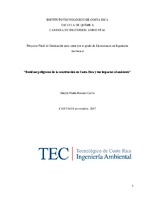Residuos peligrosos de la construcción en Costa Rica y sus impactos al ambiente
Resumen
Historically the construction sector has been one of the most important contributors in the economy, since it generates many jobs during and after the work, thus creating significant income and progress for the local economy (Myers, 2013). However, it causes significant environmental impacts as it produces a large amount of waste, some of which are considered hazardous. This sector causes, in addition, high energy consumption, greenhouse gas emissions, soil, water and air pollution (Ortiz, Castells, & Sonnemann, 2009). Despite this, in the country does not have adequate control for these wastes receives an appropriate management.
For this reason, it is intended to identify and evaluate the environmental impacts of each of the hazardous wastes generated, to generate a guide that allows the construction sector to reduce these impacts. For this purpose, 4 visits were made to construction companies, interviews and surveys were made, secondary information was taken from the project "Guide for the efficient management of construction materials", a discussion with experts was carried out, and the corresponding bibliographic review.
Among the hazardous wastes identified in construction in the country include: acids, solvents, detergents, additives for concrete, oil containers, lubricants, brake fluids, fuels, paint residue and their packaging, concrete release agent, treated wood with chemical compounds, welding residues, silicone and sealants, contaminated soil, utensils containing chemicals and fluorescent tubes (Abarca-Guerrero & Leandro-Hernandez, 2016). Each of the hazardous waste identified is associated with negative environmental impacts in soil, water or air, in addition, 100% of them have negative effects on water quality.
Despite the above, it was found that less than 40% of the surveyed companies recover for recycling or reuse said waste and none of the surveyed companies adequately manages all the hazardous waste they generate.
Descripción
Proyecto de Graduación (Licenciatura en Ingeniería Ambiental) Instituto Tecnológico de Costa Rica, Escuela de Química, 2017.


